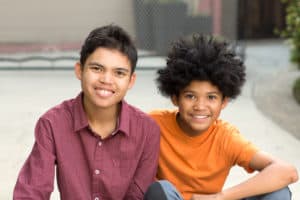We got the call for our second placement on May 29, 2020. “We know you are not interested in fostering teens, but…”
Four days later, he moved in.
Our boys were 19, 13, and 12 when “D” came to us. At 15. Everything we have ever been told about fostering was, “Don’t foster kids that are older than your youngest.” And we were committed to following that advice. Until…
Sometimes, it really is as easy as pausing to listen. Do not underestimate the power in that. God speaks in the pause, friends. Because 30 seconds into hearing his story, we knew he was meant to be ours.
I won’t go into detail about the years of abuse and, yes, torture this boy endured at the hands of those who were supposed to love and protect him the most. I will tell you that he had every reason to be angry, rebellious, and violent. Except he wasn’t. He was hurting, shy, full of protective instincts for others, yet wanting to end his life. He didn’t see a way out of the darkness. If you have ever seen the hit movie “The Blind Side,” you know the story of Michael Oher. Our foster son was a lot like him.
The cry of my heart is to tell you about the thousands of teens in foster care right now that need a safe place and people to love and believe in them. Twenty thousand teens will age out of the foster care system this year when they turn 18. Left on their own, with no place to go and no one to call, the majority of them will face homelessness, young parenthood, unemployment, and possibly addiction and sexual exploitation.
Now I know fostering teens can feel overwhelming. They can feel scary and intimidating. I was there too. In the beginning, I was in constant “Mama Bear” mode with my younger boys. But then: God. He showed up big for me, and those fears and doubts melted away. I learned that most of my worries, while valid, simply were not true. My experience with fostering a teen was pretty incredible. And I will do it again someday.

Teens in foster care come to you at a point where every single decision they make can alter the course of their life. The good news is that most of them can verbalize their pasts, as well as their needs. But I learned that connection comes first, healing second. You would be amazed what a late-night coffee run or a trip to the mall for a new pair of shoes will do for them. Again, it’s practicing the pause and meeting them where they are.
We never outgrow our need for family. Everyone wants to belong. Older children who get connected to a family can learn a sense of stability, have lasting connections, and receive guidance with important life tasks. You can help them enroll in higher education, find stable housing, secure employment, and establish healthy relationships. It’s FUN fostering teens!
Two weeks after “D” came to live with us, we were told that somebody had contacted his “father.” Anytime a child or teen enters foster care, the social workers look at the birth certificate first. If one of the child’s parents is not currently living with the child, they will contact that parent. Their next step is to contact any known kin to see if they will take the child. There was a man listed on D’s birth certificate as his father. Although he was married to D’s mother when D was born, he was not the biological father, which made this a kinship placement, also known as “kinship care.” Kinship care is when someone provides care for a child in foster care with whom they have a family relationship.

When contacted by DHS, this man and his new wife immediately said “YES” – they would adopt D. Fast forward two months. We all “met” over Zoom. It was an immediate and divine connection. Two weeks later, D’s “dad” was on a plane from North Carolina to Colorado to meet us. Two months after that, the dad brought his wife to visit. This time they stayed at our home, and the bond between us grew even more.
God took four perfect strangers living on opposite ends of the country, threw them together because a boy needed them, and created a beautiful story. This couple has become more than the adoptive parents. They have become family. We have weekly face time calls and daily texts. We are planning a family vacation together this fall. Who else could do that but my God?
Friends, God worked a miracle in D’s life, in my family’s life, and in his new family’s life. We sat in the darkness with our sweet boy, and we FOUGHT. Oh, how we fought for his life. And you know what? The darkness did not win. Today, he is alive and thriving in North Carolina with his new family. Jesus plucked him out of hell on earth and gave him a second chance.
Can I encourage you to say “Yes” to God more often? Yes, it will lead to places outside of your comfort zone. But it will also lead you to new growth, healing, and freedom.
The post Why Teens in Foster Care Need You appeared first on Focus on the Family.
Continue reading...
Four days later, he moved in.
Embracing a Teen in Foster Care
Our boys were 19, 13, and 12 when “D” came to us. At 15. Everything we have ever been told about fostering was, “Don’t foster kids that are older than your youngest.” And we were committed to following that advice. Until…
Sometimes, it really is as easy as pausing to listen. Do not underestimate the power in that. God speaks in the pause, friends. Because 30 seconds into hearing his story, we knew he was meant to be ours.
I won’t go into detail about the years of abuse and, yes, torture this boy endured at the hands of those who were supposed to love and protect him the most. I will tell you that he had every reason to be angry, rebellious, and violent. Except he wasn’t. He was hurting, shy, full of protective instincts for others, yet wanting to end his life. He didn’t see a way out of the darkness. If you have ever seen the hit movie “The Blind Side,” you know the story of Michael Oher. Our foster son was a lot like him.
Teens in Foster Care at Risk of Aging Out
The cry of my heart is to tell you about the thousands of teens in foster care right now that need a safe place and people to love and believe in them. Twenty thousand teens will age out of the foster care system this year when they turn 18. Left on their own, with no place to go and no one to call, the majority of them will face homelessness, young parenthood, unemployment, and possibly addiction and sexual exploitation.
Now I know fostering teens can feel overwhelming. They can feel scary and intimidating. I was there too. In the beginning, I was in constant “Mama Bear” mode with my younger boys. But then: God. He showed up big for me, and those fears and doubts melted away. I learned that most of my worries, while valid, simply were not true. My experience with fostering a teen was pretty incredible. And I will do it again someday.
A Pivotal Stage of Life

Teens in foster care come to you at a point where every single decision they make can alter the course of their life. The good news is that most of them can verbalize their pasts, as well as their needs. But I learned that connection comes first, healing second. You would be amazed what a late-night coffee run or a trip to the mall for a new pair of shoes will do for them. Again, it’s practicing the pause and meeting them where they are.
We never outgrow our need for family. Everyone wants to belong. Older children who get connected to a family can learn a sense of stability, have lasting connections, and receive guidance with important life tasks. You can help them enroll in higher education, find stable housing, secure employment, and establish healthy relationships. It’s FUN fostering teens!
The Story of D’s Kinship Placement
Two weeks after “D” came to live with us, we were told that somebody had contacted his “father.” Anytime a child or teen enters foster care, the social workers look at the birth certificate first. If one of the child’s parents is not currently living with the child, they will contact that parent. Their next step is to contact any known kin to see if they will take the child. There was a man listed on D’s birth certificate as his father. Although he was married to D’s mother when D was born, he was not the biological father, which made this a kinship placement, also known as “kinship care.” Kinship care is when someone provides care for a child in foster care with whom they have a family relationship.

When contacted by DHS, this man and his new wife immediately said “YES” – they would adopt D. Fast forward two months. We all “met” over Zoom. It was an immediate and divine connection. Two weeks later, D’s “dad” was on a plane from North Carolina to Colorado to meet us. Two months after that, the dad brought his wife to visit. This time they stayed at our home, and the bond between us grew even more.
God took four perfect strangers living on opposite ends of the country, threw them together because a boy needed them, and created a beautiful story. This couple has become more than the adoptive parents. They have become family. We have weekly face time calls and daily texts. We are planning a family vacation together this fall. Who else could do that but my God?
God’s Providence through a Kinship Placement
Friends, God worked a miracle in D’s life, in my family’s life, and in his new family’s life. We sat in the darkness with our sweet boy, and we FOUGHT. Oh, how we fought for his life. And you know what? The darkness did not win. Today, he is alive and thriving in North Carolina with his new family. Jesus plucked him out of hell on earth and gave him a second chance.
“Do not underestimate God’s ability to work through ordinary, faithful, and God fearing [people] who are willing to stand where they are, use what they have, and do what is in front of them.” – Katie Westenberg
Can I encourage you to say “Yes” to God more often? Yes, it will lead to places outside of your comfort zone. But it will also lead you to new growth, healing, and freedom.
“Saying yes is scary, but saying no is a waste. I’d rather be scared where God is calling me than be comfortable where He isn’t.” – Joel Nobis
The post Why Teens in Foster Care Need You appeared first on Focus on the Family.
Continue reading...





